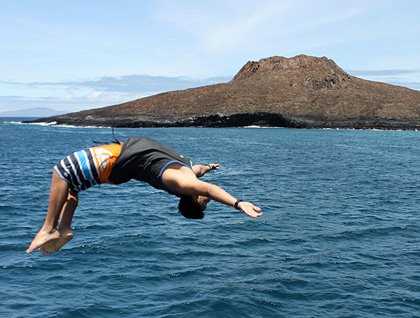A brand new day found us with the splendid view of Sombrero Chino and the Bainbridge Islets. These striking parasitic cones of Santiago Island are believed to have been formed a long time ago when the sea level was lower in this area. Sombrero Chino can be roughly translated in English as “Chinese Hat”. It has an extended peculiar shape that is reminiscent of a huge hat, like the ones worn in some regions of China. This unusual and conspicuous shape is typically found in oceanic islands of volcanic origin. These kinds of formations are also known as “shield volcanoes”.
After breakfast we explored the area by our trustworthy Zodiacs. The Zodiac ride was a very successful one for we had the chance to cover a relatively long distance, admiring the astonishing volcanic landscape and looking for wildlife. Galapagos penguins, several heron species, marine iguanas and Galapagos sea lions were admired and photographed.
Once onboard we put on our snorkeling gear to continue exploring the area, but this time by going deep-water snorkeling. The underwater world in this location was at its bests today for it was sunny and the waters were very clear and warm. We had great sightings, like some Galapagos penguins swimming swiftly, Galapagos sea lions fishing, many colorful tropical fish species and several white tip reef sharks. At the end of the snorkeling session we enjoyed the cool ocean in a very different fashion: jumping from the platform of the National Geographic Islander! It was a lot fun for all who participated of this amusing activity.
At lunch time the ship was repositioned to the south of the fourth largest islands of the Galapagos archipelago, Santiago Island. On our way to Santiago Island we sailed near Bainbridge Islet to spot some Greater flamingos at an inner brackish lake inside the crater.
In the early afternoon our guests had their second “Paper to Pearls” workshop of the week. Later on, naturalist Salvador Cazar had a presentation on “Charles Darwin and the Theory of Evolution”.
In the late afternoon we disembarked at Sullivan Bay for a fascinating hike on fairly recent lava flow. The lava we observed today is believed to be just a little more than a hundred years old. It came from an eruption that was witnessed as recently as the year 1897. Most of the hike was over smooth “pahoehoe” or ropy lava with many “aa” lava patches here and there. Along the way we observed some volcanic formations like cinder cones, spatter cones, and “hornitos” tree casts.
As the day was coming to an end we returned to the ship with the company of the last sunrays of the day and with our hearts and minds replenished with new adventures and great memories.







